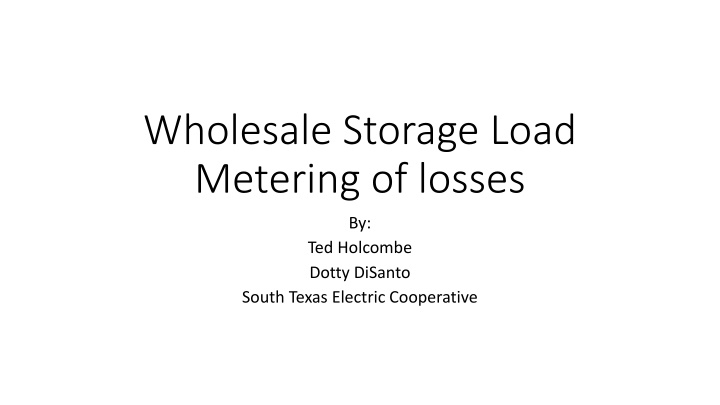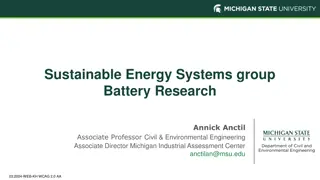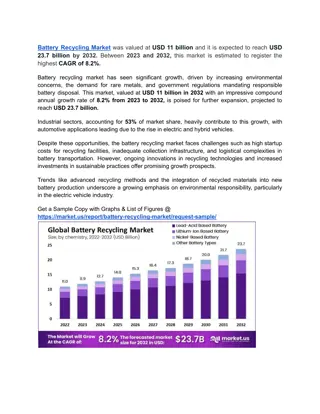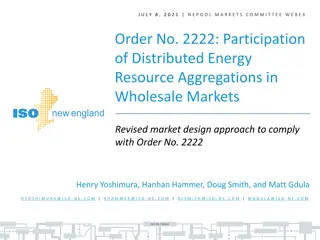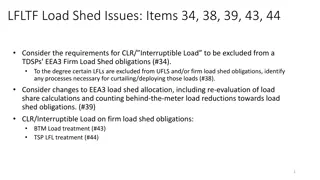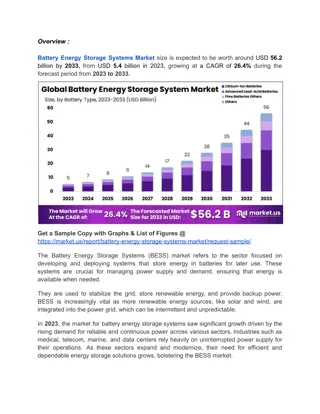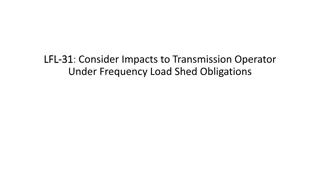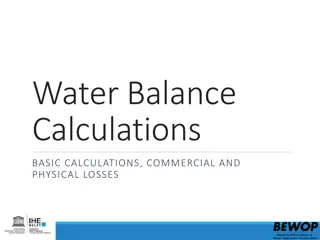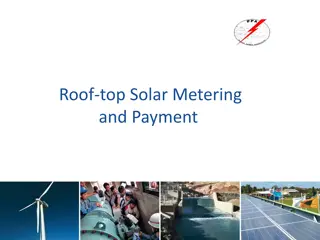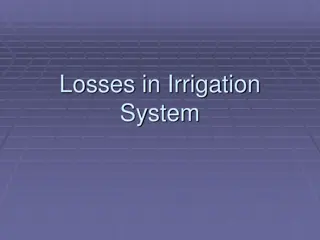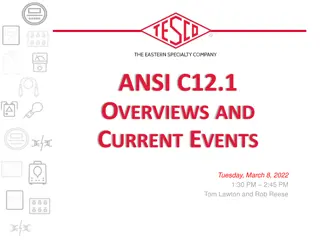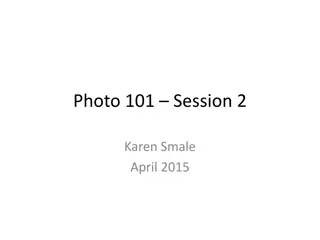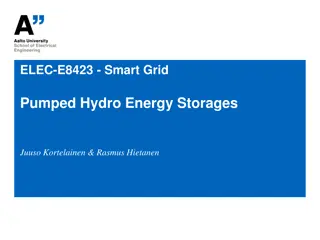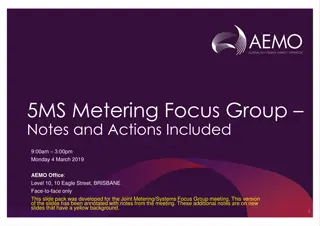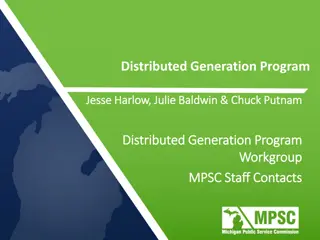Wholesale Storage Load Metering of Losses in Distributed Generation Battery Facility
Example system configuration in ERCOT involving a wholesale storage load metering system to track losses in a distributed interconnected generation battery facility. The system includes electrical storage systems, generation resources, and distribution generation components. Challenges arise in determining losses at the TDSP transformer due to the distribution load and auxiliary loads in the station. The settlement points for distributed generation and wholesale storage loads are also addressed.
Uploaded on Sep 18, 2024 | 1 Views
Download Presentation

Please find below an Image/Link to download the presentation.
The content on the website is provided AS IS for your information and personal use only. It may not be sold, licensed, or shared on other websites without obtaining consent from the author.If you encounter any issues during the download, it is possible that the publisher has removed the file from their server.
You are allowed to download the files provided on this website for personal or commercial use, subject to the condition that they are used lawfully. All files are the property of their respective owners.
The content on the website is provided AS IS for your information and personal use only. It may not be sold, licensed, or shared on other websites without obtaining consent from the author.
E N D
Presentation Transcript
Wholesale Storage Load Metering of losses By: Ted Holcombe Dotty DiSanto South Texas Electric Cooperative
A Distributed Interconnected Generation Battery Storage Facility in ERCOT can be any of the following: 1. Electrical Storage System (ESS) 2. Electrical Storage Resource (ESR) 3. A Whole Sale Storage Load (WSL) 4. Generation Resource (GR) 5. Distribution Generation (DG)
Example System Configuration POI Service Delivery Point * Change of ownership and SDP from Coop to ESR * Settlement Point for DG and WSL Distribution Station Battery Units WSL to Charge Battery (EPS Channel 1) TDSP Substation transformer EPS Metering TDSP Metering Feeder Breaker Transmission Voltage Generation from Discharge of Battery (EPS Channel 4) 200 Distribution Line Owned by cooperative 20 Distribution Line Owned by cooperative Feeder Breaker Distribution Load Distribution (DSP) Metering Auxiliary Load AC, Lighting, security, etc. TDSP kWh settled as: TDSP Ch1 Del - TDSP Ch4 Rec - EPS CH1 Del + EPS Ch4 Rec Battery Facility Coop
Loss of TDSP Transformer cannot be determined by the EPS meter due to the transformer carrying the WSL/ES and the distribution load of the station. Example System Configuration Service Delivery Point * Change of ownership and SDP from Coop to ESR * Settlement Point for DG and WSL POI Distribution Station Loss of 200 of distribution line loss cannot be determined by the EPS meter due to the line carrying the WSL/ES and the auxiliary load Battery Units WSL to Charge Battery (EPS Channel 1) TDSP Substation transformer EPS Metering TDSP Metering Feeder Breaker Transmission Voltage Generation from Discharge of Battery (EPS Channel 4) 200 Distribution Line Owned by cooperative 20 Distribution Line Owned by cooperative Feeder Breaker Distribution Load Distribution (DSP) Metering Auxiliary Load AC, Lighting, security, etc. TDSP kWh settled as: TDSP Ch1 Del - TDSP Ch4 Rec - EPS CH1 Del + EPS Ch4 Rec Battery Facility Coop
TDSP kWh settled as: kWh= TDSP Ch1 Del - TDSP Ch4 Rec - EPS CH1 Del + EPS Ch4 Rec Notes: When the battery charges: 1. TDSP incurs distribution line loss and increased transformer loss. 2. WSL incurs no losses When the battery discharges at a rate less than station load: 1. TDSP incurs no distribution line loss and decreased transformer loss 2. ES incurs no losses When the battery discharges at a rate greater than station load: 1. TDSP incurs no distribution line loss and increased transformer loss depending on meter programing. 2. ES incurs no losses.
Vague rewording of 10.3.2.3 may be the premise of metering at a distribution generator's SDP.
Topics for Discussion 1. What is the INTENT of ERCOT? Distribution connected Generation is settled at the SDP(Service Delivery Point) WSL is settled at the SDP (Service Delivery Point) Both points are at the SDP 2. Is clarification needed in Protocol or SMOG to better define the settlement point of WSL/ES metering as the POI or SDP? 3. Because watts loss is a function of I^2R, accurate division of losses between two entities sharing a common line or transformer cannot be accomplished. 4. A loss splitting calculation method must be developed and programmed into the TDSP meter. The splitting algorithm may need to be determined by the MWG and placed in Protocols or the SMOG. 5. Depending on loss splitting algorithms, communications between the WSL EPS meter and the TDSP meter may be required for real time data transfer. 6. The TDSP meter will need to calculate losses whether it is located at the ERCOT POI or at any other location. The calculated losses must be accessible in order to apply splitting algorithms. 7. Meters with such complex programming are difficult to test and lend themselves to technician error. 8. When thinking about transformer and distribution line loss, is this a give and take? When the battery charges, the TDSP incurs increased transformer and distribution line loss. When the battery discharges, the TDSP incurs decreased transformer loss and no line loss. This is not a perfect break-even because of battery efficiency but is it enough to be concerned about? 9. Are large or different operational WSL/ES facilities arriving in the future that could result in losses captured by TDSP metering being more substantial? 10. Is STEC the only entity that has interest in this topic?
